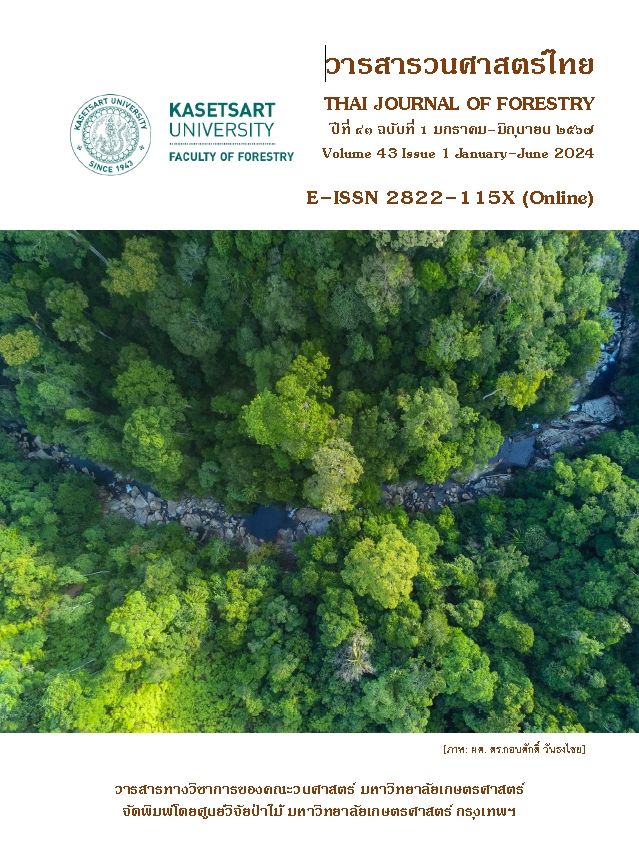ผลของความหนักเบาในการตัดขยายระยะต่อผลผลิตและรูปทรงของไม้สัก กรณีศึกษา สวนป่าเอกชน อำเภอเมือง จังหวัดอุตรดิตถ์
Main Article Content
บทคัดย่อ
การตัดขยายระยะเป็นหนึ่งในวนวัฒนวิธีเพื่อการเพิ่มผลผลิตของสวนป่าโดยการพิจารณาเลือกตัดไม้ออกโดยพิจารณาจากชั้นเรือนยอดหรือระยะห่างระหว่างต้นไม้ การศึกษาครั้งนี้มีวัตถุประสงค์เพื่อศึกษาผลของความหนักเบาในการตัดขยายระยะต่อผลผลิตและรูปทรงของไม้สักในพื้นที่สวนป่าเอกชน ในจังหวัดอุตรดิตถ์ โดยสวนป่าสักมีระยะปลูก 4 เมตร x 4 เมตร ทำการวางแปลงตัวอย่างแบบสุ่มสมบูรณ์ในบล็อค (randomized complete block design, RCBD) จำนวน 3 รูปแบบการทดลอง ทำการตัดขยายระยะแบบชั้นเรือนยอดต่ำ (low thinning) ตามความหนักเบาของการตัดขยายระยะโดยใช้เกณฑ์ร้อยละของพื้นที่หน้าตัดรวมของหมู่ไม้ที่ตัดออกไป ได้แก่ ระดับปานกลาง (moderate thinning) คิดเป็นร้อยละ 40 ระดับหนัก (heavy thinning) คิดเป็นร้อยละ 60 เมื่อไม้มีอายุ 10 ปี เปรียบเทียบกับการไม่ตัดขยายระยะ (unthinned stand) เป็นแปลงควบคุม ทำการเก็บข้อมูลหลังการตัดขยายระยะ 9 ปี พบว่า ความหนาแน่นของหมู่ไม้ในแปลงไม่ตัดขยายระยะมีค่าสูงกว่าแปลงตัดขยายระยะอย่างมีนัยสำคัญยิ่ง ค่าเฉลี่ยขนาดเส้นผ่านศูนย์กลางเพียงอกและค่าเฉลี่ยปริมาตรรายต้นในแปลงตัดขยายระยะมีค่ามากกว่าแปลงไม่ตัดขยายระยะอย่างมีนัยสำคัญทางสถิติ แต่การตัดขยายระยะไม่มีผลต่อความสูงของต้นไม้ สำหรับค่าความเพิ่มพูนเฉลี่ยรายปี (MAI) ด้านเส้นผ่านศูนย์กลางเพียงอกของต้นไม้ทั้งหมดในแปลงตัดขยายระยะระดับหนักมีค่ามากกว่าแปลงไม่ตัดขยายระยะอย่างมีนัยสำคัญทางสถิติ จากการคำนวนปริมาตรไม้ในส่วนของลำต้นพบว่า ค่าปริมาตรหมู่ไม้ ความเพิ่มพูนเฉลี่ยของปริมาตรหมู่ไม้ และปริมาตรรวมทั้งหมดไม่แตกต่างกันอย่างมีนัยสำคัญทางสถิติ อย่างไรก็ตาม แปลงที่ไม่ตัดขยายระยะได้สูญเสียปริมาตรไม้จากการตายตามธรรมชาติมากกว่าแปลงตัดขยายระยะ การศึกษารูปทรงของต้นไม้ เพื่อศึกษาเสถียรภาพของต้นไม้ พบว่าค่าอัตราส่วนของเรือนยอดที่มีชีวิตอยู่ ในแปลงตัดขยายระยะมีค่ามากกว่าแปลงที่ไม่ได้ตัดขยายระยะอย่างมีนัยสำคัญยิ่ง ในทางตรงกันข้ามอัตราส่วนระหว่างความสูงต่อขนาดเส้นผ่านศูนย์กลางเพียงอก และค่าฟอร์มแฟกเตอร์ที่ของต้นไม้แปลงตัดขยายระยะมีค่าต่ำกว่าแปลงไม่ตัดขยายระยะอย่างมีนัยสำคัญทางสถิติ จึงกล่าวได้ว่าความหนักเบาของการตัดขยายระยะส่งผลต่อการเพิ่มขนาดความโตของต้นไม้ และส่งผลดีต่อการปรับปรุงรูปทรงของต้นไม้
Downloads
Article Details

อนุญาตภายใต้เงื่อนไข Creative Commons Attribution-NonCommercial-NoDerivatives 4.0 International License.
ข้าพเจ้าและผู้เขียนร่วม (ถ้ามี) ขอรับรองว่า ต้นฉบับที่เสนอมานี้ยังไม่เคยได้รับการตีพิมพ์และไม่ได้อยู่ในระหว่างกระบวนการพิจารณาตีพิมพ์ลงในวารสารหรือสิ่งตีพิมพ์อื่นใด ข้าพเจ้าและผู้เขียนร่วม (ถ้ามี) ยอมรับหลักเกณฑ์และเงื่อนไขการพิจารณาต้นฉบับ ทั้งยินยอมให้กองบรรณาธิการมีสิทธิ์พิจารณาและตรวจแก้ต้นฉบับได้ตามที่เห็นสมควร พร้อมนี้ขอมอบลิขสิทธิ์ผลงานที่ได้รับการตีพิมพ์ให้แก่วารสารวนศาสตร์ คณะวนศาสตร์ มหาวิทยาลัยเกษตรศาสตร์ กรณีมีการฟ้องร้องเรื่องการละเมิดลิขสิทธิ์เกี่ยวกับภาพ กราฟ ข้อความส่วนใดส่วนหนึ่ง หรือ ข้อคิดเห็นที่ปรากฏในผลงาน ให้เป็นความรับผิดชอบของข้าพเจ้าและผู้เขียนร่วม (ถ้ามี) แต่เพียงฝ่ายเดียว และหากข้าพเจ้าและผู้เขียนร่วม (ถ้ามี) ประสงค์ถอนบทความในระหว่างกระบวนการพิจารณาของทางวารสาร ข้าพเจ้าและผู้เขียนร่วม (ถ้ามี) ยินดีรับผิดชอบค่าใช้จ่ายทั้งหมดที่เกิดขึ้นในกระบวนการพิจารณาบทความนั้น”
เอกสารอ้างอิง
Forestry Commission. 2015.Field Guide Thinning Control. https://cdn.forestresearch.gov.uk/2015/09 /fcfg004.pdf, 23 October 2023. (in Thai)
Gonçalves, A.C. 2020. Thinning: An overview. Silviculture, 1: 1-19. doi:10.5772/intechopen.93436
Himaphan, W. 2023. How to Selected Tree for Thinning. Silvicultural Research Group. Forest Research and Development Bureau Royal Forest Department. http://forprod.forest.go.th/forprod/silvic /for_plant/JIRCAS-1, 5 March 2023. (in Thai)
Land Development Department. 2023. 62 Soil Series Groups. http://oss101.ldd.go.th/web_thaisoils/62_ soilgroup/main_62soilgroup.htm, 18 April 2023. (in Thai)
Meteorological Department. 2023. Index Data by Province. http://climate.tmd.go.th/data/province/pdf, 18 April 2023. (in Thai)
Oyebade, B.A., Eguakun, F.S., Egberibin, A. 2015. Tree Slenderness Coefficient (TSC) and tree GrowthCharacteristics (TGCS) for Pinus caribaea in Omo Forest Reserve, Nigeria. IOSR Journal of Environmental Science, Toxicology and Food Technology (IOSR-JESTFT), 9(3): 56-62. doi: 10.9790/2402-09325662
Pandey, D., Brown, C. 2000. Teak: a global overview. Unasylva, 201(51): 3-13.
Phusudsawang, A. 2010. Economic Plantation and Management of Teak for Farmers and the Private Sector. Augsorn Siam Printing. Bangkok, Thailand. (in Thai)
Royal Forest Department (RFD). 2015. Guidelines Thinning Method for Commercial Forest Plantations. Kaew Chao Chom Media and Publishing Center, Suan Sunandha Rajabhat University. Bangkok, Thailand. (in Thai)
Royal Forest Department (RFD). 2017. Techniques to Increase Productivity for Teak Plantations, The Final Report of the Research Project Sustainable Teak Plantation, Management Plan for Farmers. http://forprod.forest.go.th/forprod/silvic/for_plant/data/RFD/3.pdf, 28 January 2023. (in Thai)
Royal Forest Department (RFD). 2022. Silvicultural for Increasing Growth, Yield and Methods for Estimating Production of Teak Plantations. http://forprod.forest.go.th/forprod/silvic/for_plant /Research-1.html, 28 January 2023. (in Thai)
Sahunalu, P. 1999. Applied Ecology in Silviculture. Faculty of Forestry, Kasetsart University. Bangkok, Thailand. (in Thai)
Suwannaphinan, W. 2002. Silvicultural System (3rd ed.). Department of Silviculture. Bangkok, Thailand. (in Thai)
The Customs Department. 2023. Statistical Data. http://www.customs.go.th/statistic_report, 6 March 2023. (in Thai)
Vacharangkura, T., Himmapan, W. 2018. Variable-top merchantable volume equations for teak (Tectona grandis Linn. f.) in Thailand. Journal of Forest Management, 12(24): 1-13. (in Thai)
Vacharangkura, T., Wiribancha, C. 2002. Clear-cutting extension and stump sprouting of teak plantations: growth of teak plantations during 3 - years period after clear-cutting extension. In Proceedings of the Forestry Conference 2002. "The Potential of Forests for Thai Economic Recovery". Department of Forestry, Ministry of Agriculture and Cooperatives. Bangkok, Thailand. pp. 83–102. (in Thai)
Wang, Y., Titus, S.J., LeMay, V.M. 1998. Relationships between tree slenderness coefficients and tree or stand characteristics for major species in boreal mixedwood forests. Canadian Journal of Forest Research, 28(8): 1171–1183. doi.org/10.1139/x98-092


